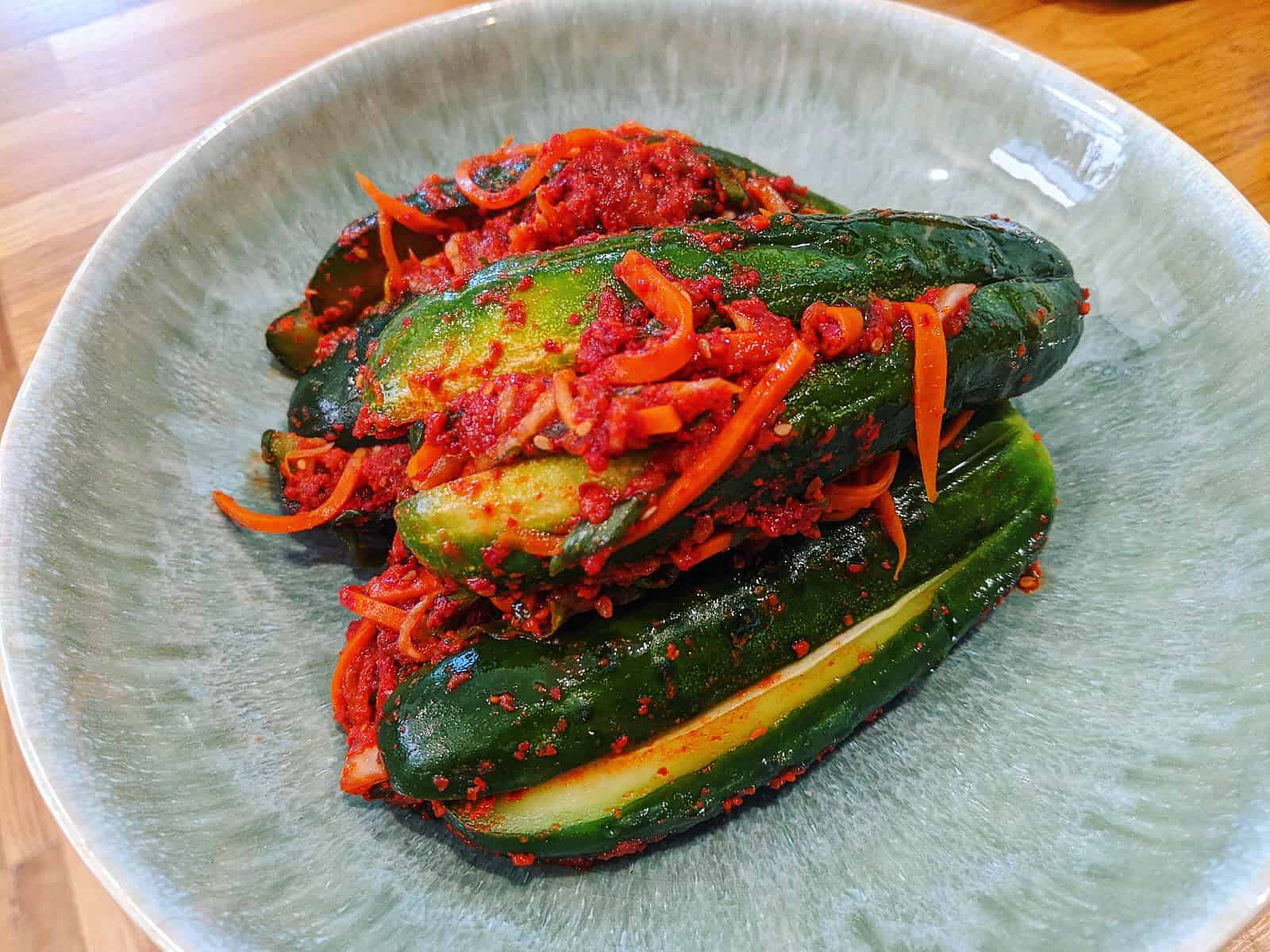In the realm of Korean cuisine, Oi-Sobagi stands out as a refreshing and vibrant side dish that adds a burst of flavor to any meal. Also known as stuffed cucumber kimchi, Oi-Sobagi features crisp cucumbers stuffed with a spicy, tangy, and garlicky filling. This blog will guide you through the process of making this traditional Korean delicacy, from selecting the perfect cucumbers to mastering the art of stuffing them with delectable kimchi ingredients.
Understanding Oi-Sobagi:
Oi-Sobagi translates to “stuffed cucumber” in Korean, reflecting the essence of this dish. Unlike other types of kimchi, Oi-Sobagi features whole cucumbers that are carefully slit and filled with a mixture of seasoning ingredients. The result is a visually stunning dish with a delightful combination of textures and flavors.
Ingredients You’ll Need:
- Cucumbers: Choose firm, slender cucumbers ideally suited for stuffing. Korean cucumbers are commonly used for their crisp texture, but English cucumbers or Persian cucumbers can also work well.
- Kimchi Seasoning: A mixture of Korean chili flakes (gochugaru), garlic, ginger, green onions, fish sauce (or soy sauce for a vegetarian version), and sugar creates the bold and spicy flavor profile of Oi-Sobagi.
- Optional Fillings: Feel free to add additional ingredients such as shredded carrots, radish matchsticks, or even small shrimp or crab for added complexity and texture.
Step-by-Step Preparation:

- Prepare the Cucumbers: Wash the cucumbers thoroughly and trim off the ends. Using a sharp knife, make deep lengthwise cuts into each cucumber, stopping just short of cutting all the way through. This creates a pocket for the kimchi filling.
- Make the Kimchi Seasoning: In a mixing bowl, combine the Korean chili flakes, minced garlic, grated ginger, chopped green onions, fish sauce (or soy sauce), and sugar. Adjust the seasoning to taste, ensuring a balance of spicy, salty, and sweet flavors.
- Stuff the Cucumbers: Carefully spoon the kimchi seasoning mixture into the cuts of each cucumber, ensuring that the filling reaches all the way to the bottom. Press gently to secure the filling and close the cuts.
- Fermentation: Place the stuffed cucumbers in a clean glass jar or container, pressing them tightly together to prevent them from floating. Seal the jar and let it ferment at room temperature for 1-2 days to develop the characteristic tangy flavor of kimchi.
- Chill and Serve: Once the desired level of fermentation is reached, transfer the jar of Oi-Sobagi to the refrigerator to slow down the fermentation process. Serve chilled as a refreshing side dish or accompaniment to Korean meals.
Health Benefits of Oi-Sobagi:

- Rich in Probiotics: Like other types of kimchi, Oi-Sobagi undergoes fermentation, which creates beneficial probiotics that support gut health and digestion.
- Low in Calories: Cucumbers are naturally low in calories and high in water content, making Oi-Sobagi a nutritious and hydrating snack or side dish.
- Vitamins and Minerals: Cucumbers are a good source of vitamins K and C, as well as potassium and antioxidants, contributing to overall health and well-being.
WATCH HERE>
Frequently Asked Questions (FAQs) about Oi-Sobagi:
1. What does “Oi-Sobagi” mean?
“Oi-Sobagi” is a Korean term that translates to “stuffed cucumber.” It refers to the process of hollowing out cucumbers and stuffing them with a seasoned mixture, typically made with vegetables and spices.
2. Is Oi-Sobagi spicy?
The level of spiciness in Oi-Sobagi can vary depending on the recipe and personal preference. Traditionally, Oi-Sobagi is made with a spicy kimchi seasoning, which includes Korean chili flakes (gochugaru), garlic, ginger, and other seasonings. However, the spiciness can be adjusted according to taste.
3. Can I make Oi-Sobagi ahead of time?
Yes, Oi-Sobagi can be made ahead of time and stored in the refrigerator. In fact, allowing the flavors to marinate over time can enhance the taste of the dish. Simply store the stuffed cucumbers in an airtight container and refrigerate until ready to serve.
4. How long does Oi-Sobagi last?
When stored properly in the refrigerator, Oi-Sobagi can last for several days to a week. However, it is best enjoyed within a few days of making it to ensure the cucumbers remain crisp and the flavors are fresh.
5. Can I use different vegetables for the stuffing?
While cucumbers are the traditional choice for Oi-Sobagi, you can experiment with different vegetables for the stuffing according to your preference. Some popular options include carrots, radishes, green onions, and Korean chives. Be sure to adjust the seasoning accordingly based on the vegetables used.
6. Is Oi-Sobagi vegetarian/vegan-friendly?
Yes, Oi-Sobagi can be made vegetarian or vegan-friendly by omitting any non-vegetarian ingredients such as fish sauce or shrimp. You can also use a vegan alternative to traditional kimchi seasoning if desired.
7. Can I adjust the level of saltiness in Oi-Sobagi?
Yes, you can adjust the level of saltiness in Oi-Sobagi by controlling the amount of salt added to the seasoning mixture. Start with a smaller amount of salt and adjust to taste as needed. You can also rinse the cucumbers after salting them to remove excess saltiness if desired.
8. Can I serve Oi-Sobagi with other dishes?
Yes, Oi-Sobagi pairs well with a variety of Korean dishes and can be served as a side dish alongside rice, grilled meats, or Korean stews. Its refreshing flavor and crunchy texture complement the richness of other Korean dishes.
9. Can I make Oi-Sobagi with different types of cucumbers?
While traditional Korean cucumbers (kirby cucumbers) are commonly used for Oi-Sobagi, you can use other varieties of cucumbers such as English cucumbers or Persian cucumbers. However, keep in mind that the size and texture of the cucumbers may affect the stuffing process and overall flavor of the dish.
10. Is Oi-Sobagi gluten-free?
Yes, Oi-Sobagi is naturally gluten-free as it does not contain any wheat-based ingredients. However, it’s essential to check the labels of any store-bought seasonings or condiments to ensure they are gluten-free if following a gluten-free diet.
